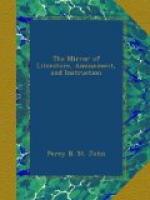Title: The Mirror of Literature, Amusement, and Instruction Volume 17, Number 490, Saturday, May 21, 1831
Author: Various
Release Date: June 22, 2004 [EBook #12676]
Language: English
Character set encoding: ASCII
*** Start of this project gutenberg EBOOK mirror of literature, no. 490 ***
Produced by Jonathan Ingram, David Garcia and the
Online Distributed
Proofreading Team.
THE MIRROR OF LITERATURE, AMUSEMENT, AND INSTRUCTION.
Vol. XVII, no. 490.] Saturday, may 21, 1831. [Price 2d.
* * * * *
[Illustration: Old house in Southwark.]
This crazy, but not unpicturesque building, was taken down in the autumn of last year, in forming an approach to the New London Bridge. It stood on the eastern side of the High-street, and is worthy of record among the pleasing relics of antiquity, which it has ever been the object of The Mirror to rescue from oblivion. Its style of architecture—that of the seventh Henry—is interesting: there is a florid picturesqueness in the carvings on the fronts of the first and second stories, and probably this ornament extended originally to the uppermost stories, which had subsequently been covered with plaster.
We remember the house for the last twenty years, but cannot trace this or any other alteration in its front. The windows, it will be seen, are of different periods, those on the right-hand second and the left-hand third floor being of the oldest date.
Apart from these attractions, and as a specimen of the olden domestic architecture of the metropolis, the annexed Cut bears an historic interest, in its having been the residence of the ill-starred Anne Boleyn, queen of Henry the Eighth. The interior was in palatial style, having been elaborately finished; and in one of the apartments, we learn that the royal arms were very conspicuous.
In early times, Southwark was one of the most celebrated of the metropolitan suburbs; and it is much to be regretted that the liberality of our times has not encouraged the production of its ancient history. Every one at all familiar with London is aware of the antiquity of St. Saviour’s Church, the original foundation of which was from the profits of a ferry over the Thames, whence its original name, St. Mary Overy, or “over the ferry.” This was some time before the Conquest; but the church was principally rebuilt in the fourteenth century. We have spoken of its ancient fame elsewhere.[1] Bankside, its name in spiritual and secular story, is likewise of some note. The early Bishops of Winchester had a palace and park here; remains of the former were laid open by a fire about seventeen years since. Then, who does not remember, in the love of sports and pastimes, the bull and bear-baiting theatres, and the uncouth glory of the Globe theatre, associated with the poet of all time—Shakspeare. Southwark was, therefore, a fitting site for a royal palace for occasional retirement, and its contiguity to the Thames must have enhanced its pleasantness.




